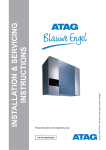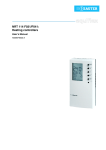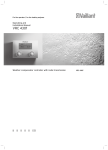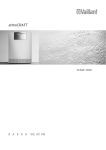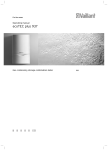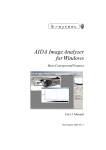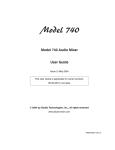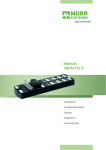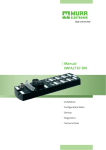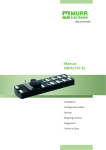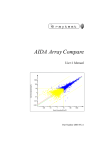Download Vaillant VRC 430f Installation manual
Transcript
For the operator/for the heating engineer Operating and Installation Manual VRC 430 Weather compensator GB VRC 430 For the operator Operating Manual VRC 430 Weather compensator VRC 430 Contents Appliance features.....................................................4 Application ............................................................................4 Product features..................................................................4 4.3 4.3.1 4.3.2 4.3.3 4.4 1 1.1 1.2 1.3 1.4 Notes on the documentation......................... 5 Storing of the documents .....................................5 Symbols used ...........................................................5 Applicability of the manual...................................5 CE label ......................................................................5 2 Safety ............................................................... 5 3 3.1 3.2 3.3 3.4 3.5 Notes on operation ......................................... 6 Intended use .............................................................6 Environmental conditions .....................................6 Care ............................................................................6 Vaillant warranty.....................................................6 Recycling and disposal ..........................................6 4.7.2 4.7.3 4.7.5 Operating concept ..................................................8 Show various display screens ..............................9 Changing parameters.............................................9 Operation in the simplified basic display ..........11 The period of validity for new control system target values.............................................12 Operator level, Expert technician level ............13 Screens in the operating level for the operator....................................................................13 Changing the displays (examples) .................... 15 Entering time programmes (example for heating circuit) ...................................................... 15 Programming holiday periods ........................... 16 Entering parameters for the heating circuit ........................................................................17 Entering parameters for hot water generation............................................................... 18 Renaming the heating components ................. 18 4 4.1 4.2 Operation ......................................................... 7 Overview operating and display front ...............7 Overview of the display (display field) ..............8 5 Status and error messages. .........................19 4.5 4.6 4.7 4.7.1 4.7.4 Appliance features Appliance features Application The VRC 430 is a weather compensator controller for heating and generating hot water. "Weather compensator" means: at low external temperatures the VRC 430 provides more heating output, and at higher external temperatures lower heating output. The outside temperature is measured by a separate outdoor sensor, and the results are transmitted to the VRC 430. The room temperature is based only on your preset values. The system compensates for the effect of the external temperature. You can use the VRC 430 to set different room target temperatures - for different times of the day and for different days of the week. In automatic mode, the VRC 430 controls your heating according to these settings (see Fig. 0.1). The VRC 430 can also be used to control the following accessory components: – Circulation pump for hot water generation in conjunction with a multi-functional module 2 of 7 – Conventional domestic hot water cylinder – Vaillant layer hot water storage tank actoSTOR – Second heating circuit using the Vaillant Mixer Module VR 61 – Solar unit using the Vaillant Solar Module VR 68 The VRC 430 can be operated with the Vaillant remote control VR 81. The VRC 430 can form part of a new heating and hot water generation unit or can also be retro-fitted into an existing installation. The heating unit must have an eBUS interface. eBUS is a communications standard for data exchange between heating technology components. Room temperature With the VRT 430 you can also control times for heating and hot water generation. 25 ° 20 ° Set back temperature 15 ° Period 1 04:00 08:00 Period 2 12:00 16:00 Period 3 20:00 Time Fig. 0.1 Automatic heating operation: Example, setting the target room temperature for different times of day Product features – eBUS interface – Data connection with a Vaillant heating unit via an eBUS line – Illuminated graphical display (display field) – Operation via both dials according to the Vaillant "turn and click" principle – Direct fitting of the controller in the operating panel of the heating unit or separate wall mounting – Equipped for operation with Vaillant diagnostics software vrDIALOG 810/2 and with the Vaillant Internet Communication System vrnetDIALOG, i.e. Remote diagnosis and settings 4 Operating Manual VRC 430 0020042468_02 Notes on the documentation 1 Safety 2 1 Notes on the documentation The following information is intended to help you work through the documentation. Additional documents apply in combination with this operating manual. We accept no liability for any damage caused by failure to observe these instructions. Other applicable documents – The installation instructions for the Vaillant controller VRC 430 (Section 2 of this document For the expert technician: – The operating and installation manual for your heating system – All instructions for accessory components 1.3 Applicability of the manual This operating manual applies exclusively to units with the following article number: 0020028520 The article number of your unit can be obtained from your expert technician. 1.4 CE label The CE mark documents the fact that the Vaillant controller VRC 430 fulfils the fundamental requirements of the relevant guidelines. 2 Glossary: At the end of this document, in the appendix, you will find an explanation of technical terms and important functions listed in alphabetical order. 1.1 Storing of the documents Please store this operating manual and all related documents in such a way that they are available whenever required. 1.2 Symbols used Please observe the safety instructions in this manual when operating the unit. Danger! e Danger of death by electrocution! d Danger! Immediate risk of serious injury or death! Caution! H Danger of burning and scalding! Caution! a Potentially dangerous situation for the product and environment! VRC 430 Safety The VRC 430 may only be installed by a suitably qualified expert technician. This engineer also assumes responsibility for properly installing and starting up the unit. H Caution! Risk of being scalded by hot water! At the draw-off locations for the hot water there is a danger of scalding at temperatures in excess of 60 °C. Young children and elderly persons can be in danger even at lower temperatures. Select the set target temperature to prevent injury to all persons (see section 4.7.4). Caution! Risk of being scalded by hot water! If your expert technician has activated the anti-legionella function for your domestic hot water cylinder, the hot water at certain drawoff points may reach temperatures above 60 °C. Contact your technician to find out if this function has been activated, and if so, for which days and times. h Note! Useful information and instructions. ⇒ Symbol indicating a required task Operating Manual VRC 430 0020042468_02 5 3 Notes on operation 3 Notes on operation 3.1 Intended use The VRC 430 weather compensator is a state-of-the-art appliance manufactured in accordance with recognised safety regulations. However, damage and property may occur if the unit is used improperly or for a purpose other than the intended purpose. The VRC 430 controller is designed as a weather compensator timer-controlled heating unit with or without hot water generation/circulation pump in conjunction with a Vaillant boiler with eBUS interface. Operation with the following accessories is permitted: – Circulation pump for hot water generation in conjunction with a multi-functional module 2 of 7 – Conventional domestic hot water cylinder – Vaillant layer hot water storage tank actoSTOR – Second heating circuit using the Vaillant Mixer Module VR 61 – Solar unit using the Vaillant Solar Module VR 68 – VR 81 remote control device Any other or extended use is considered to be use other than intended. The manufacturer or supplier is not liable for any resulting damage. The owner alone bears any risk. Intended use also includes observing the operating and installation instructions and all other applicable documents. 3.3 Care Clean the enclosure of the VRC 430 with a damp cloth. Never use scouring or cleaning agents which could damage the operating elements or the display. 3.4 Vaillant warranty We only grant a Vaillant manufacturer's warranty if a suitably qualified engineer has installed the system in accordance with Vaillant instructions. The system owner will be granted a warranty in accordance with the Vaillant terms and conditions. All requests for work during the guarantee period must be made to Vaillant Service Solutions (ane 0870 6060 777). 3.5 Recycling and disposal Both your VRC 430 and its packaging are primarily made of recyclable raw materials. Appliance Neither the VRC 430 nor any of its accessories may be disposed of in the household waste. Make sure the old appliance and any accessories are disposed of properly. Packaging Please leave the disposal of the transport packaging to the qualified servicing company which installed the appliance. 3.2 Environmental conditions If the "thermostat" function is active and the VR 81 remote control unit is not connected, please ensure: – the unit is not blocked by furniture or other obstacles. – the radiator valves in the room in which the VRC 430 is fitted are fully open. "room temperature compensation" means that the current room temperature is evaluated by the VRC 430 and taken into account in the control system. Your expert technician will advise you whether the "room temperature compensation" is activated. 6 Operating Manual VRC 430 0020042468_02 Operation 4 4 Operation h Note! Ask your expert technician to explain how to operate the VRC unit after it has been installed. This will prevent accidental changes being made to the settings. 4.1 Overview operating and display front Th. 12.01.06 11:46 3.0 °C Outside 1 19.0 °C Auto VRC 430 3 2 Fig. 4.1 Overview operating and display front Key 1 Display (display field) 2 Controls, right-hand dial 3 Controls, left-hand dial Fig. 4.1 shows the default display. The default display shows the following information: – the operating mode (automatic, manual or off) of the heating circuit 1 – the current internal temperature The default display is described in detail in Chapter 4.3.3. The functions of the two dials are described in Chapter 4.3. Operating Manual VRC 430 0020042468_02 7 4 Operation 4.2 Overview of the display (display field) The parameters (operating values) of the controller for display and entry are shown on the various display screens. The display screens are sub-divided into: – Default display (Fig. 4.1) – Basic display (Fig. 4.2) – Display/input screens for certain specific parameters in the operator level (see Chapter 4.4 and 4.5) – Display/input screens for operating and installationspecific parameters at installer level All display screens are split into three areas. Th. 12.01.06 11:46 HC1 3.0 °C Outside 21.0 °C Auto 56.0 °C Auto DHW 1 4.3 Operating concept The operating instructions for the simplified basic display are given in Chapter 4.3.3. The operating concept described below applies to the basic display (Fig 4.2) and the various display/input screens in the operator level. The two dials (Fig. 4.1 Items 2 and 3) function according to the Vaillant "turn and click" principle. When the dials are turned (forwards or backwards) you can hear them click into position. When the dial clicks into the adjacent position, the display also moves to the corresponding adjacent position. Click (press) to select or accept an adjustable parameter. Action Result Left-hand dial Turn Jump to the next display screen Right-hand dial Turn Jump to an input field within a screen (marked by the cursor) 2 > Select room temperature 3 Fig. 4.2 Overview displays (example basic display) Key 1 Area for basic data, title of the screen or status and error messages 2 Area for displaying and entering parameters 3 Area for displaying explanations The basic data is: – Day – Date – Time – External temperature Changing a parameter (succession) Click (press) Activate for the entry (highlighted display) Turn Select the parameter value Click (press) Save selected parameter values Table 4.1 Operating concept In the display/input screens for specific parameters, the title of the screen appears instead of the basic data. Th. 12.01.06 11:46 Outside 3.0 °C HC1 DHW 21.0 °C Auto 56.0 °C Auto > Select room temperature 1 2 3 4 Fig. 4.3 Area for displaying and entering parameters (example basic display) Key 1 Parameter name (display only) 2 Cursormarks the jump to a modifiable value 3 Input field for parameter values; here: set target temperature 4 Input field for parameter values; here: Operating mode 8 Operating Manual VRC 430 0020042468_02 Operation 4 4.3.1 Show various display screens You can scroll through the individual screens of the display, like you do with a book, by turning the left-hand dial. 4.3.2 Changing parameters ⇒ Rotate the right-hand adjuster to jump to the individual modifiable parameters within the display screen. Example: You are now in the basic display. Instructions for accessing the basic display are given in Chapter 4.3.3 The position is indicated by thecursor (see Fig. 4.5). ⇒ Turn the left-hand dial one position (click) clockwise. If a parameter (e.g. a date with day, month, year) has several elements, jump from one element to the next by rotating the right-hand dial. The screen now shows display page 1 with the options for making changes to the basic data. Th. 12.01.06 11:46 HC1 3.0 °C Th. 12.01.06 11:46 HC1 21.0 °C Auto 56.0 °C Auto > Select room temperature 1 Date 21 . 06 . 06 We Day of week Time 12 : 00 Summer/winter time changeover Auto 56.0 °C Auto 3.0 °C Outside HC1 21.0 °C Auto DHW 56.0 °C Auto Th. 12.01.06 11:46 HC1 HC1 Time programme > Select day of week Auto > Select operation mode > Set day of week 06 : 00 - 10 : 40 : : : : 21.0 °C > Select room temperature Th. 12.01.06 11:46 Basic data Mo 1 2 3 Outside Outside DHW DHW 3.0 °C 2 21.5 °C DHW 3.0 °C Outside 21.0 °C Auto 56.0 °C Auto > Select target hot water Fig. 4.5 Jump to the various modifiable parameters Fig. 4.4 Displaying various screens Operating Manual VRC 430 0020042468_02 9 4 Operation ⇒ ⇒ Press the right-hand dial. Rotate the right-hand dial to display in sequence the optional values for this parameter The parameter valuemarked by the cursor is highlighted. Th. 12.01.06 11:46 Th. 12.01.06 11:46 HC1 DHW 3.0 °C HC1 Outside 21.0 °C Auto 56.0 °C Auto 3.0 °C Outside 21.0 °C Auto 56.0 °C Auto DHW > Select room temperature > Select room temperature Th. 12.01.06 11:46 Fig. 4.6 Marking a modifiable parameter HC1 3.0 °C Outside 21.5 °C Auto 56.0 °C Auto DHW > Select room temperature Th. 12.01.06 11:46 HC1 3.0 °C Outside 22.0 °C Auto 56.0 °C Auto DHW > Select room temperature Fig. 4.7 Changing a parameter value ⇒ Press the right-hand dial. The displayed value is confirmed and accepted for the control system. The value display changes from highlighted to normal. 10 Operating Manual VRC 430 0020042468_02 Operation 4 Hot water Heating circuit 1 (HC1) Changing the parameters in the basic display Parameters Meaning Room set target temperature The heating is adjusted according to the modified room target temperature. The length of this control period depends on the operating mode, see also Chapter 4.4. Operating mode Auto(matic) The control system of the heating unit is according to the stipulation of the room target temperature, the time programme and other parameters such as set-back temperature and heating curve. Some of these parameters are set by your expert technician. h Note! The simplified basic display always appears if Operating mode Manual The control system of the heating unit is according to the set room target temperature. Operating mode Off The heating unit is switched off. The target room temperature is not displayed and can therefore not be changed. Frost protection is guaranteed. Hot water target value Hot water generation is generated according to the new target hot water value. The duration of this control system depends upon the operating mode, see also Chapter 4.4. In the case of the default display (Fig. 4.8) the operating mode for heating circuit 1 and the internal temperature is displayed in the centre section. The default display also allows you to change the two most important parameters of your heating system quickly and comfortably: – You can change the operating mode (automatic, manual, off) by rotating the left-hand dial. – By rotating the right-hand dial you can change between the display of the internal temperature and the input/modification of the target room temperature. Operating mode Auto(matic) The hot water is generated according to the target hot water temperature and time settings. Operating mode Manual The hot water control system is based on the hot water target value. Operating mode Off Hot water generation is switched off. The target hot water value is not displayed and is also not modifiable. Frost protection is guaranteed. Table 4.2 Modifiable parameters in the basic display Example: Changing the heating circuit target room temperature 1 (HC1) Initial situation: You are now in the basic screen (see Fig. 4.2). Instructions for accessing the basic display are given in Chapter 4.3.3 ⇒ ⇒ The new value is set. The display jumps highlighted to normal. The period for which the new control system value remains valid depends on the current operating mode; 4.4 4.3.3 Operation in the default display the mixer module VR 61 (for a second heating circuit) is not connected and the VRC 430 is wall-mounted (not on the front of the heating unit). Th. 12.01.06 11:46 Auto 3.0 °C Outside 19.0 °C VRC 430 Fig. 4.8 Simplified basic display (example) Click one or both of the dials to move from the simplified basic display to the next screen (see Fig. 4.2). If there has been no operation of the controller for a period in excess of 5 minutes, the display jumps back to the simplified basic display. Turn the right-hand dial until the cursorappears in front of the target value (target room temperature) for heating circuit 1 (HC1). Press the right-hand dial. The input field for the set target value is highlighted. ⇒ Turn the right-hand dial. The target room temperature changes by 0.5 °C for every dial position (click). ⇒ When you reach the required room target temperature , Press the right-hand dial. Operating Manual VRC 430 0020042468_02 11 4 Operation Changing the operating mode in the simplified basic display Operating mode Meaning Auto(matic) The heating circuit is controlled according to the target room temperature, the timer programmes, as well as other parameters such as set-back temperature and heating curve. Some of these parameters are set by your expert technician. Manual The heating circuit is controlled according to the room target temperature. Off The heating circuit is switched off. The target room temperature is not displayed and also cannot be changed. Frost protection is guaranteed. ⇒ Turn the right-hand dial. The current room target temperature is highlighted rather than the interior temperature. After a delay of 1 second you can select the new target room temperature: ⇒ Rotate the right-hand dial until the desired target room temperature appears. After a delay of 2 seconds the selected target room temperature is accepted. The display then changes form highlighted to normal and shows the internal temperature. Table 4.3 Operating modes for the heating unit Proceed as follows: ⇒ Rotate the left-hand dial. The operating mode is highlighted. After a delay of 1 second, you can select the operating mode by rotating the left-hand dial. After 2 seconds, the display returns to normal. The selected operating mode is accepted. 3.0 °C Th. 12.01.06 11:46 Auto Outside 20.5 °C > Select room temperature Fig. 4.10 Changing the target room temperature in the basic display Th. 12.01.06 11:46 Manual 3.0 °C Outside 19.0 °C > Select operation mode The period for which the new value remains valid depends on the current operating mode; see also Chapter 4.4. 4.4 The period of validity for new control system target values If you changed a set target value in the basic display — either the room target temperature or the hot water target value — the new value now applies to the entire system. Fig. 4.9 Changing the operating mode in the default display Changing the target room temperature in the default display The heating unit is controlled according to the room target temperature. The control system ensures that the target room temperature is achieved quickly and maintained at this value. For this to happen the selected heating curve must correspond to the conditions and the room temperature control function must be activated. 12 In the "manual" operating mode the control system operates according to the new value until either the operating mode or the value is changed. In "automatic" operating mode the control system uses the new value until the next period starts (if you changed the set target value outside a time period) or until the end of the current period (if you changed the set target value within the time window; see Fig. 4.11. Operating Manual VRC 430 0020042468_02 Room temperature Operation 4 4.5 Operator level, Expert technician level The VRC 430 controller has two operating levels. Each level contains several display screens where the parameters can be displayed, set or changed. 25 ° – Operating level for the operator This is used to display, set/change the basic parameters. The parameters can be set/changed by an unskilled operator and during normal operation. 20 ° Set back temperature 15 ° – Operating level for the expert technician This is used to display and set/change specific parameters and is restricted to the expert technician. Period 4.6 Room temperature 08:00 12:00 Time 25 ° 2 3 1 20 ° Screens in the operating level for the operator The screens in the operation level for operators are arranged the same sequence as shown in table 4.4. below. This table shows the parameters which can be set and changed. Examples of this can be seen in chapter 4.7 below. To access the first "basic data" screen at operator level from the simplified basic view: 4 ⇒ 15 ° Click one or both dials. This will take you to the basic display. Period 08:00 ⇒ 12:00 Turn the left-hand dial clockwise one or two positions (clicks). Time Fig. 4.11 Period of validity of changed set target value (here: Target room temperature The top diagram in Fig. 4.11 shows a programmed period (see Chapter 4.7.1) with the associated room set temperature (21 °C). Basic data 1 Date Day of week Time 21 . 06 . 06 We 12 : 00 Summer/winter time changeover Auto > Set day of week The lower diagram, the bar marked (1), shows that the target room target value is changed (20 °C). This target value is maintained until the start of the new period. From here (2) the control system uses the room set target value of the time window (21 °C). At (3) the room set target value is set (17 °C). The control system applies this value until the end of this period (4). After this period, the control system reverts to the setback temperature (15 °C). Fig. 4.12 "Basic data" screen (Example: selecting the day of the week) Turn the left-hand dial again to jump from one screen to the next. If additional components are installed and controlled by the VRC 430, the display screens listed in table 4.4 will contain the additional screens as required, e.g. 3 or 6. h Note! The same applies to the hot water target value. Operating Manual VRC 430 0020042468_02 13 4 Operation Display screen 1 Title display screen adjustable operating values (only display = A) Remarks Basic data Date Day Time Day, Month and Year selected separately; Hours and minutes selected separately Unit Min. value Max. value Summer/Winter changeover 2 4 5 7 HC1 Time programmes Hot water timer programmes Circulation pump time programmes Holiday programme for overall system IncrePreset ment/ value selection option Auto, Off Day/block Select single day or block of days (e.g. Mo-Fr) 1 Start/end time 2 3 There are three time periods available for each day or block of days Hours/ minutes Temperature per period Individual room target temperatures can be set for each period °C Day/block Select single day or block of days (e.g. Mo-Fr) 1 Start/end time 2 3 Three time periods are available per day or block of days Day/block Select single day or block of days (e.g. Mo-Fr) 1 Start/end time 2 3 Three time periods are available per day or block of days Holiday period Start Day, Month, Year End Day, Month, Year Holiday set target value heating Target room temperature °C for holiday period Off 10 min 5 30 0,5 Hours/ minutes 10 min Hours/ minutes 10 min Frost protection, 20 30 0,5 Frost protection 5 30 0,5 15 0,2 4 0,05-0,1 1,2 or 5 8 HC1 parameters Set-back temperature You can specify a setback temperature for the times between the holiday periods. If your expert technician has set the frost protection function, the setback temperature is automatically 5 °C. There is no set-back temperature display. Heating curve The supply temperature of the heating is controlled as a function of the external temperature This relationship is represented in heating curves. You can select from a variety of heating curves (see Chapter 4.7.3). °C Table 4.4 Screens in the operating level for the operator 14 Operating Manual VRC 430 0020042468_02 Operation 4 Display screen Title display screen adjustable operating values (only display = A) Remarks Unit Min. value Max. value Step distance Preset value 10 Hot water parameters Hot water target value Set target temperature for hot water generation °C 35 70 1,0 60 14 Changing the name Heating circuit 1 You can enter any name containing up to 8 characters Heating circuit 1 Access for the expert technician only by entering saved code number 1000 Hot water 15 Release code level Code number Hot water Table 4.4 Screens in the operating level for the operator (continued) 4.7 Changing the displays (examples) 4.7.1 Entering time programmes (example for heating circuit) The timer programmes can be used to specify up to three time periods for each day or each block of days (e.g. Mo - Fr). During these time periods the heating control system maintains the set room temperature, the so-called comfort temperature. The temperature is set back outside these time periods. h ⇒ Turn the left-hand dial until the screen 2, HC1 timer programme, appears . HC1 Time programme Mo 1 2 3 06 : 00 - 10 : 40 : : : : > Select day of week Fig. 4.13 Screen 2 21.5 °C Turn the right-hand dial until the cursoris located in front of the input field for a day or block of days. Press the right-hand dial. The input field is highlighted. ⇒ Note! If you carefully adjust the time window according to your lifestyle, you will save energy without losing your heating comfort. The procedure for setting the time windows is described below heating circuit 1 as an example Time windows can be set in the same way for the hot water preparation and for a circulation pump. ⇒ ⇒ ⇒ Turn the right-hand dial to select the day or block of days. The following selections are available: – Mon, Tue, ... etc. – Mon - Fri (Block) – Sat - Sun (Block) – Mon - Sun (Block) Confirm your selection by pressing right-hand dial. 1, 2 and 3 on the screen refer to the "time window" that you can set for the selected day or block of days. Within the time window (e.g. from 06:00 am to 10:40 am) the controller regulates the heat as per the comfort temperature (e.g. 21.5 °C). ⇒ ⇒ Rotate the right-hand dial until the cursoris located in front of the field for the entering start time for time window 1. Press the right-hand dial. The input field is highlighted. ⇒ Select the start time by rotating the right-hand dial. 2 (example) The time jumps in ten-minute increments for every turn (click) of the dial. ⇒ Operating Manual VRC 430 0020042468_02 When the start time is displayed, confirm by clicking the right-hand dial. 15 4 Operation The time for the end of the time window 1 should be set accordingly. The input field is highlighted. 4.7.2 Programming holiday periods If you will not be home for an extended period, you can set a lower target room temperature for that period. This will save heating energy. The controller ensures that the heater heats up the living rooms to the set temperature only. You can, for example, specify a target room temperature of 15 °C if you are on holiday from the 10th to the 24th of February. The rooms will only be heated to 15 °C during this period. You can also select the frost protection function instead of the target room temperature. ⇒ Proceed as follows to programme a holiday period: The desired comfort temperature for time window 1 is set as follows: ⇒ ⇒ ⇒ Rotate the right-hand dial until the cursoris in front of the field for the entering comfort temperature for time window 1. Press the right-hand dial. Turn the right-hand dial to select the desired comfort temperature (the temperature jumps by 0.5 °C for every click). When the comfort temperature is displayed, confirm by pressing the right-hand dial. Note! The controller helps the operator to programme the time windows: You can only enter sequential entries. The timer for a subsequent window cannot be earlier than a previous one. A time window may only be between 0:00 and 24:00. An existing time window can be deleted as follows: Set the start time and the end of a window to the same time. Note! Set the timer for warm water generation and circulation pump in the same way as for the example, heating circuit 1. There is no need to enter a comfort temperature for hot water generation and circulation pump. ⇒ Turn the left-hand dial until screen 7 "holiday programming for entire system" is displayed. Holiday programming for cpl. system 7 10 . 02 . 06 - Period: . . Frost prot. Room temp.: > Set starting day Fig. 4.14 Screen ⇒ 7 (example) Turn the right-hand dial until the cursor isat the beginning of the start date. The comment field contains the text "Set starting day". ⇒ Press the right-hand dial. The input field is highlighted. ⇒ ⇒ Turn the right-hand dial until the desired starting day is displayed. Press the right-hand dial. The start date is set. The display jumps highlighted to normal. ⇒ Set the month and year in which the start date occurs in the same way. The comment field contains the text "Set starting month" or "Set starting year". ⇒ Set the end date for the holiday period in the same way. Enter the target room temperature as follows: ⇒ 16 Turn the right-hand dial until the cursoris in front of the input field for the target room temperature. Operating Manual VRC 430 0020042468_02 Operation 4 The comment field contains the text "Select target room temperature". ⇒ Press the right-hand dial. The input field is highlighted. ⇒ ⇒ Turn the right-hand dial until the desired value is displayed (values from 5 °C to 30 °C in increments of 0.5 °C and frost protection function are possible). Press the right-hand dial. Example: If you select a heating curve of 1.5 with a target room temperature of 20 °C, the controller provides a heating flow temperature of 56 °C at an outside temperature of 0 °C. The various heating curves indicate whether the heating flow temperature should be higher or lower depending on the outside temperature. h Note! In a well-insulated apartment a comfortable room temperature can be achieved even with a flat heating curve. This saves heating energy. Your expert heating technician will provide advice as to which heating curve should be selected. The desired target room temperature or the frost function are set. The display jumps highlighted to normal. 4.7.3 Entering parameters for the heating circuit You can enter the following parameters: Set-back temperature Outside the specified time windows, the heating is reduced to the set-back temperature. If your expert technician has set the frost protection function, the set-back temperature will automatically be 5 °C. There is no display of set-back temperature. Proceed as follows to enter the parameters (example heating circuit 1): ⇒ HC1 Parameter 8 "HC1 param- 8 Set back temperature Heating curve Heating curve The relationship between the outside temperature and the required heating feed temperature is represented in a diagram having various different heating curves (see Fig. 4.15). Each heating curve (from 0.2 - 4.0) gives a value for the heating flow temperature (vertical diagram axis) for the individual outside temperature (horizontal diagram axis). Turn the left-hand dial until screen eters" is displayed. 15 . 0 ° C 1.2 > Select temperature Fig. 4.16 Display screen ⇒ 8 (example) Turn the right-hand dial until the cursoris in front of the input field for the set-back temperature. The comment field contains the text "Set temperature". ⇒ Press the right-hand dial. The input field is highlighted. ⇒ ⇒ Turn the right-hand dial until the desired value is displayed (values from 5 °C to 30 °C in increments of 0.5 °C are possible). Press the right-hand dial. The desired set-back temperature is set. The display jumps highlighted to normal. ⇒ Fig. 4.15 Diagram with heating curves for a target room temperature of 20 °C The display field shows the text "set heating curve" in the comment field. ⇒ Operating Manual VRC 430 0020042468_02 Turn the right-hand dial until the cursoris in front of the heating curve value. Press the right-hand dial. 17 4 Operation The input field is highlighted. ⇒ ⇒ Turn the right-hand dial until the desired value is displayed (values from 0.2 to 4.0 are possible, see Fig. 4.15). Press the right-hand dial. The desired heating curve is set. The display changes from highlighted to normal. You can enter a new name to the right of the colon (numbers 0-9, spaces, capital/small letters). Proceed as follows: ⇒ ⇒ ⇒ The characteris highlighted. 4.7.4 Entering parameters for hot water generation If the heating unit also heats your hot water, you can enter the set target temperature on the controller. ⇒ ⇒ ⇒ Turn the left-hand dial until screen parameters" is displayed. 10 "Hot water The cursoris located in front of the value for the set target temperature. ⇒ Turn the left-hand dial until screen 14 "Change names" is displayed. Turn the right-hand dial until the cursoris in front of the name you wish to change. Press the right-hand dial. Turn the right-hand dial until the desired letter or number is displayed. Press the right-hand dial. The character is accepted. The character switches from highlighted to normal. ⇒ Turn the left-hand dial clockwise by one click. Press the right-hand dial. The next character is marked by the cursor. The input field is highlighted. ⇒ ⇒ ⇒ Turn the right-hand dial until the desired value is displayed (values from 35 °C to 70 °C in increments of 1 °C are possible). Press the right-hand dial. The desired set target temperature is set. The display jumps highlighted to normal. H Caution! Risk of being scalded by hot water! At the draw-off locations for the hot water there is a danger of scalding at temperatures in excess of 60 °C. Young children and elderly persons can be in danger even at lower temperatures. Select the target temperature so that nobody is in danger. Press the right-hand dial. The character is highlighted. ⇒ ⇒ Turn the right-hand dial until the desired letter or number is displayed. Proceed in the same way for the rest of the characters in the name. h Note! You can delete entire names or extra characters by entering spaces. 4.7.5 Renaming the heating components Screen 14 indicates which components you can rename. Change names 14 HC1 : DHW : Bathroom 1 : HC1 > Select Fig. 4.17 Screen 18 14 (example) Operating Manual VRC 430 0020042468_02 Status and error messages 5 5 Status and error messages Status and error messages are displayed in the second row of the basic data section. Status messages – Holiday programme active Within a specified holiday period the heating is controlled according to the temperatures set for that period. – Maintenance + telephone number of the expert technician Indicates that the heating system requires maintenance work. The telephone number of your expert technician will also appears if it has been entered into the system. Error message: Fault on heating unit. Draws attention to a fault in the heating unit. ⇒ Contact your expert technician. The unit is faulty if the screen remains dark or you are unable to make any changes using the dial. ⇒ Contact your expert technician. Operating Manual VRC 430 0020042468_02 19 For the heating engineer: Installation Manual VRC 430 Weather compensator VRC 430 Contents 1 1.1 1.2 1.3 Notes on the documentation.........................2 Storing of the documents .....................................2 Symbols used ...........................................................2 Applicability of the manual...................................2 5 5.1 2 2.1 2.2 2.3 Description of the appliance ......................... 3 Identification plate ..................................................3 CE label ......................................................................3 Intended use .............................................................4 5.3 3 3.1 3.2 Safety instructions and regulations ............4 Safety information..................................................4 Regulations ...............................................................4 4 4.1 4.2 4.3 4.4 4.5 4.6 Assembly ......................................................... 5 Scope of delivery ....................................................5 Accessories ...............................................................5 Location .....................................................................5 Fitting the controller in the heating unit ..........5 Wall mounting the controller ...............................6 Fitting the external sensor ...................................6 5.2 Installation....................................................... 7 Electrical installation of the controller when mounted on the wall ...................................7 Electrical installation of theexternal sensor VRC 693.......................................................8 Electrical installation of the external sensor VRC 9535 ....................................................8 6 6.1 6.2 6.3 6.4 6.5 Initial start-up ................................................. 9 Installation assistant ..............................................9 Expert technician level ..........................................9 Restoring default parameters ........................... 10 Grout drying function ...........................................13 Handing over the appliance to the owner .......13 7 7.1 7.2 Service, warranty ..........................................13 Vaillant service .......................................................13 Vaillant warranty....................................................13 8 Recycling and disposal ................................. 14 9 Technical data ............................................... 14 Glossary .....................................................................15 1 Notes on the documentation 1 Notes on the documentation The following information is intended to help you work through the documentation. Additional documents apply in conjunction with this installation manual. We accept no liability for any damage caused by failure to observe these instructions. 1.3 Applicability of the manual These installation instructions apply exclusively to appliances with the following article numbers: 0020028520 VRC 430 The part number of your unit can be obtained from the identification plate. Other applicable documents – The operating instructions for the Vaillant controller VRC 430 (Section 1 of this document) – The operating and installation instructions for your heating unit – All instructions for accessory components 1.1 Storing of the documents Please pass on this installation manual and all other valid documents and auxiliary equipment to the owner of the unit. This person is responsible keeping these documents safe. The documents must be made available if required. 1.2 Symbols used Please observe the safety instructions in this manual when installing the unit! Danger! e Danger of death by electrocution! Danger! d Immediate risk of serious injury or death! Caution! H Danger of burning and scalding! Caution! a Potentially dangerous situation for the product and environment! h Note! Useful information and instructions. ⇒ 2 Symbol indicating a required task Installation Instructions VRC 430 0020042468_02 Description of the appliance 2 2 Description of the appliance 1 2 3 The VRC 430 is a weather compensator designed for heating and hot water generation in conjunction with a Vaillant boiler (eBUS-capable). The VRC 430 can also be used to control the following accessory components: – Circulation pump for hot water generation in conjunction with a multi-functional module 2 of 7 – Conventional domestic hot water cylinder – Vaillant layer hot water storage tank actoSTOR – Second heating circuit using the Vaillant Mixer Module VR 61 – Solar unit using the Vaillant Solar Module VR 68 On the VRC 430 data is exchanged and power supplied via an eBUS interface. The VRC 430 can be operated with the Vaillant remote control VR 81. The VRT 430 is equipped for operation with the Vaillant diagnosis software vrDIALOG 810/2 and with the Vaillant Internet Communication System vrnetDIALOG, i.e. for remote diagnosis and remote setting. 230 V~ 5 4 Fig. 2.1 System diagram Key 1 VRC 430 2 External sensor VRC 693 or VRC 9535 (DCF) 3 Boiler 4 Cable connection (VRC 693: twin core; VRC 9535: 3 core) 5 eBUS connection (twin core) 2.1 Identification plate The identification plate is located on the rear of the controller electronics (printed circuit board). 2.2 CE label The CE label indicates that the Vaillant controller VRC 430 complies with the basic requirements of the following guidelines: – Electromagnetic compatibility directive (Guideline 89/336/EEC) – Low voltage directive (Guideline 73/23/EEC) Installation Instructions VRC430 0020042468_02 3 2 Description of the appliance 3 Safety instructions and regulations 2.3 Intended use The VRC 430 weather compensator is a state-of-the-art appliance constructed in accordance with recognised safety regulations. However, damage and property may occur if the unit is used improperly or for a purpose other than the intended purpose. The VRC 430 controller is designed for use as a weather compensator and timer-based controller with or without hot water generation/ circulation pump in conjunction with a Vaillant heating unit with eBUS interface. Operation with the following accessories is permitted: – Circulation pump for hot water generation in conjunction with a multi-functional module 2 of 7 – Conventional domestic hot water cylinder – Vaillant layer hot water storage tank actoSTOR – Second heating circuit using the Vaillant Mixer Module VR 61 – Solar unit using the Vaillant Solar Module VR 68 – VR 81 remote control device Any other or extended use is considered to be use other than intended. The manufacturer or supplier is not liable for any resulting damage. The owner alone bears any risk. Intended use also includes observing the operating and installation instructions and all other applicable documents. 3 Safety instructions and regulations The controller must be installed by a suitably qualified expert technician, who is responsible for observing existing standards and regulations. We accept no liability for any damage caused by failure to observe these instructions. 3.1 Safety information Danger! e Live connections! There is a danger to life from electrocution when working on the electronics box of the boiler. Switch off the power supply to the electronics box of the heating unit and secure against reconnection before carrying out any work. Only open the electronics box if the heating unit is disconnected from the power source. 3.2 Regulations During the electrical installation, observe the VDE and EVU regulations. Use standard commercial cables for wiring. Minimum cross-section for sensor and Bus lines: 0.75 mm2 Do not exceed the following maximum wire lengths: – Sensor lines 50 m – eBUS lines 300 m If sensor and eBUS lines run parallel with 230 V cables for more than 10 m, they must be laid separately. Do not use free terminals of the appliances as support terminals for other wiring. The controller may only be installed in dry rooms. All wiring must be in accordance with Building Regulations Part P and BS 7671 (IEE Wiring Regulations), and must be carried out by a suitably qualified person. 4 Installation Instructions VRC 430 0020042468_02 Assembly 4 4 Assembly The VRC 430 can either be integrated in the heating unit or mounted separately in the living area on a wall. When mounting on the wall, the connection to the heating unit is via a twin-core eBUS line. The VRC 430 is supplied with one of the following external sensors: – VRC 693 connection is via a twin core cable to the heating unit – VRC 9535 (DCF) connection is via a 3-core cable to the heating unit 4.1 Scope of delivery Using Table 4.1, check the scope of delivery h Note! If accessory components are connected to the VRC 430, the instructions for these components must also be observed. 4.3 Location The controller should only be installed in dry rooms. If the controller is mounted on the wall, it should be fitted in such a way that the room temperature is measured properly; e.g. on an internal wall of the main living room, at a height of approx. 1.5 m If the thermostat function is activated, advise the operator that all the radiator valves must be fully open in the room where the controller is mounted. Pos. Number Component 1 1 Controller VRC 430 See Chapter 4.6 for information on locating the outdoor sensor. 2 1 External sensor VRC 693 or External sensor VRC 9535 (DCF) 4.4 3 1 Fixing material 4 1 6-pole edge connector 5 1 Operating and Installation Manual Danger! e Live connections! There is a danger to life from electrocution when working on the electronics box of the boiler. Switch off the power supply to the electronics box of the heating unit and secure against reconnection before carrying out any work. Only open the electronics box if the heating unit is disconnected from the power source. Table 4.1 Scope of supply VRC 430 4.2 Accessories The following accessories can be used to extend controller functionalities: 2 of 7 multi-functional modules The multi-function module VR 2 of 7 can be used by the VRC 430 to control a circulation pump. VR 61 mixer module The mixer-module VR 61 extends the VRC 430 functionality to include a twin-circuit controller. Solar module VR 68 The solar module VR 68 can be used by the VRC 430 to control a solar installation. VR 81 remote control unit The remote control VR 81 is recommended if the VRC 430 is fitted in the heating unit, or if the second heating circuit is to be controlled decentrally. The remote control VR 81 can be used to set the following parameters: – Operating mode – Target room temperature Fitting the controller in the heating unit Proceed as follows: ⇒ ⇒ ⇒ ⇒ ⇒ ⇒ ⇒ ⇒ Switch the boiler off. Turn off the power supply to the heating unit and secure the power supply against re-connection. Remove the front screen from the heating unit. Carefully press the controller (without wall plinth, see Fig. 4.1) with the pin rail into the plug connector on the heating unit. Now fit the external sensor (see Chapter 4.6), if not already done. Carry out the electrical installation of the external sensor as described in Chapter 5.2 or 5.3. Re-connect the power supply to the heating unit. Switch the heating unit on again. Symbols are displayed indicating maintenance and error messages. Data interchange is via eBus line. Installation Instructions VRC430 0020042468_02 5 4 Assembly 4.5 4.6 Fitting the external sensor The mounting location of the external sensor should meet the following conditions: - not fully protected from wind - no particularly draughty - no direct sunlight - no influence from heat sources - N or NW facing facade Wall mounting the controller 1 On buildings with up to 3 floors, the external sensor should be two-thirds up the building; on buildings with more than 3 floors, install it between the 2nd and 3rd floors. 2 5 Caution! a Dampness in the wall and in the unit! 4 3 Fig. 4.1 Fitting the external sensor 430 Key 1 Controller VRC 430 2 Wall plinth 3 Installation opening 4 Openings for cable duct 5 Terminals for eBUS line and plug connection for pin rail Incorrect installation can result in damage to the unit and/or the wall of the building. Observe the cable routing described and the correct installation position of the external sensor. h Note! Installation is the same for both external sensors, with the following exceptions: – the VRC 693 requires a two-core connection cable – the VRC 9535 requires a three-core connection cable Proceed as follows: ⇒Pull the room thermostat (1) off the wall plinth (2). ⇒ ⇒ ⇒ ⇒ ⇒ ⇒ ⇒ This can be done by pushing a screwdriver into the two retaining straps (see Fig. 4.1 arrows). Mark the position on the wall. Take the eBUS line route into account when doing so. Drill two holes 6 mm in diameter to match the fixing apertures (3). Insert the rawl plugs supplied. Insert the eBUS cable through one of the cable conduits (4). Use the screws supplied to fix the wall socket . Electrical installation is described in Chapter 5.1. Carefully press the controller onto the wall socket until it clicks into position. The pin rail on the back of the controller must fit into the plug connector (5) on the wall socket. 1 2 3 5 3 4 4 Fig. 4.2 Fitting the external sensor VRC 693 Key 1 Casing cover 2 Wall plinth 3 Cap nut for cable conduit 4 Connection cable with drip loop 5 Installation opening 6 Installation Instructions VRC 430 0020042468_02 Assembly 4 Installation 5 5 Installation Danger! e Live connections! There is a danger to life from electrocution when working on the electronics box of the boiler. Switch off the power supply to the electronics box of the heating unit and secure against reconnection before carrying out any work. Only open the electronics box if the heating unit is disconnected from the power source. Fig. 4.3 Fitting the external sensor VRC 9535 Key 1 Casing cover 2 Wall plinth 3 Cap nut for cable conduit 4 Connection cable with drip loop 5 Installation opening Proceed as follows: ⇒ ⇒ ⇒ ⇒ ⇒ ⇒ ⇒ ⇒ ⇒ ⇒ Mark the position on the wall. Observe the cable routing for the external sensor. Route the connection cable (4) with a slight incline to the outside and with a drip loop. Remove the cover (1) from the external sensor casing. Drill two holes 6 mm in diameter to match the fixing apertures (5). Insert the rawl plugs supplied. Fix the wall socket (2) to the wall with 2 screws. The cable entry must point downwards. Release the cap nut (3) slightly and push the connection cable through the cable entry from below. The electrical installation is described in Chapter 5.2 for the VRC 693, and in Chapter 5.3 for the VRC 9535 . Re-tighten the cap nut (3). The packing in the cable entry adapts to the diameter of the cable used (Cable diameter: 4.5 to 10 mm). Carefully push the cover for the enclosure onto the wall socket until it clicks in position. Do not forget the seal between the wall socket and the cover for the enclosure. If the controller is installed in the heating unit, the electrical connection is made by the contact between the pin rail of the controller and the corresponding plug connection in the heating unit. 5.1 Electrical installation of the controller when mounted on the wall The power supply to the heating unit is switched off and secured against re-connection. 1 2 Fig. 5.1 Electrical connection with VRC 430 Key 1 Terminal rail VRC 430 2 Heating unit terminal rail Installation Instructions VRC430 0020042468_02 7 5 Installation h Note! The bridge between the terminals 3 and 4 (see Fig. 5.1) should not be removed. When connecting the eBUS cable there is no need to make sure the polarity is correct. Communication is not adversely impacted if the two connections are swapped over. Proceed as follows: ⇒ ⇒ ⇒ Connect the connection cable to the terminals on the external sensor as per Fig. 4.2. Connect the connection cable to the 6-pole edge connector as per Fig. 5.2. Connect the 6-pole edge connector to plug location X41 on the heating unit. Proceed as follows: ⇒ ⇒ 5.3 Connect the eBUS cable to the VRC 430 terminal rail. Connect the eBUS cable to the terminal rail on the heating unit. Electrical installation of the external sensor VRC 9535 The power supply to the heating unit is switched off and secured against re-connection. 5.2 Electrical installation of the external sensor VRC 693 The power supply to the heating unit is switched off and secured against re-connection. 1 1 2 Fig. 5.3 Electrical connection of the external sensor VRC 9535 2 Key 1 Terminal rail VRC 9535 external sensor 2 6-pole edge connector for plug location X41 (heating unit) Proceed as follows: Fig. 5.2 Electrical connection of VRC 693 Key 1 Connection cable to the external sensor VRC 693 2 6-pole edge connector for plug location X41 (heating unit) 8 ⇒ ⇒ ⇒ Connect the connection cable to the terminal rail of the external sensor as per Fig. 5.3. Connect the connection cable to the 6-pole edge connector as per Fig. 5.3. Connect the 6-pole edge connector to plug location X41 on the heating unit. Installation Instructions VRC 430 0020042468_02 Initial start-up 6 6 Initial start-up You can check the heating generator settings on screen A5: Initial situation: The controller and the external sensor are correctly installed and connected. The heating unit is switched on and ready for operation. h Note! Ensure that both rotary knobs The VRC 430 operating concept is described in the operating instructions in Chapter 4.3. 6.1 Installation assistant The installation assistant will help you with the initial start-up. The installation assistant recognises the components connected to the heating system. Depending on the configuration of the heating unit, up to six screens (A1 to A6) are available. You can enter the most important parameters of the heating system using the installation assistant. The installation assistant starts with screen A1, language selection. ⇒ Select the language as per the operating concept (operating instructions 4.3). Turn the left-hand dial clockwise by one click to access screen A2. Installation assistant System configuration A2 Mixer mode HC1 Cylinder DC active > Select Fig. 6.1 Installation assistant screen A2 The heating system configuration is shown on screen A2. In the heating circuit mode HC1 you can select between burner circuit (BK) and inactive. In Cylinder you can choose between active and inactive. ⇒ Turn the left-hand dial clockwise by one click to access screen A5. Installation Instructions VRC430 0020042468_02 ⇒ Select 50 °C as the parameter value for the "Activation heater" parameter. Check the boiler reaction. If you want to make any other changes: (outlet-/hot water cylinder temperature and heating flow temperature ) on the boiler are at the maximum position (all the way to the right). This ensures optimum control system by the VRT 430. ⇒ ⇒ ⇒ Turn the left-hand dial anticlockwise to return to any of the previous screens. To exit the installation assistant: ⇒ ⇒ Turn the left-hand dial clockwise to access screen A6. Click "Yes" to exit. h Note! If you confirmed the end of the installation with "yes" you can only access the installation assistant via the code-protected Expert Technician Level. 6.2 Expert technician level The expert technician level is used to display and set/ change specific operating data. This allows the control system to be set according to the heating system. This is advisable if the heating installation has other components in addition to the heating circuit 1 (HC 1)(e.g. heating circuit 2, domestic hot water cylinder, solar energy system). h Note! Please refer to the individual operating manuals for component controller function descriptions. The expert technician level includes screens C1 to C26 and the screens A1 to A6 of installation assistant as described above. Screens C1 to C26 in the VRT 430 appear in the same sequence as shown in table 6.1 below. This table shows the parameters which can be set and changed. Depending upon the configuration selected, non-required parameters are not displayed on the installation assistant (screen A2). The settings/changes take place in accordance with the operating concept as described in Chapter 4.3 of the operating instructions . In order to get to the expert technician level, you need to enter an access code. From the simplified basic display you can access the expert technician level as follows: 9 6 Initial start-up ⇒ ⇒ ⇒ Click with one or both of the dials to access the basic display from the simplified basic display. Turn the left-hand dial clockwise until screen 15 is displayed. Enter the code. Code layer enabled 15 Menu point Input Result Cancel Yes The set parameters remain effective Time programmes Yes All programmed time windows are deleted Everything Yes The default settings for all parameters are restored Table 6.1 Menu selection, default settings screen Code number 0 0 0 0 After confirming the input, the display returns to the basic display or to the simplified basic display. > Enter code Fig. 6.2 Screen 15 The default code is 1 0 0 0. You can change the code on screen C24. After entering the correct code you automatically access screen C1 on the expert technician level. 6.3 Restoring default parameters You can restore the VRC 430 default settings as follows: ⇒ Simultaneously press and hold both dials for 10 seconds You will access the screen for the default settings Th. 12.01.06 11:46 3.0 °C Outside Factory setting Cancel No Time programme No Everything Sommer/Winterzeit-Umstellung No Fig. 6.3 Default settings screen 10 Installation Instructions VRC 430 0020042468_02 Initial start-up 6 Display screen Title display screen adjustable operating values (only display = A) Remarks Unit Min. value Max. value C1 HC1 Information Supply target (A) Flow temperature target value °C 1 FBG connection/ room actual value Remote control connected? Room actual display °C Yes, no and 0.5 Installation sensor VF1 (A) Actual value at the feed sensor 1 or the internal sensor of the heat generator °C 1 Pump status (A) C3 Hot water generator information Hot water information Off, heating mode, hot water mode current hot water set target value (A) Hot water set target temperature of the storage tank °C 1 Storage probe 1 (A) Actual cylinder hot water temperature °C 1 Circulation pump status (A) C8 C9 C16 HC1 parameters HC1 parameters Hot water parameters Preset value On, Off Flame status boiler (A) C4 Step width On, Off Heating circuit type (A) Status display Heating circuit, inactive Switch-on room temperature selectable with wall mounting of the controller or remote control none, modulating, thermostat none Summer operation mode Offset If the outside temperature > target room temperature + Summer Offset, the boiler switches off R 0 30 1 1 Set-back temperature You can specify a setback temperature for the times between the holiday periods. If your expert technician has set the frost protection function, the set-back temperature is automatically 5 °C. There will be no display as set-back temperature °C 5 30 1 15 Heating curve in accordance with the diagram operating instructions Chapter 4.7.3 0,2 4 0,05-0,1 1,2 Minimum temperature Minimum feed temperature 15 90 1 15 Legionella protection day Day or block of days; The cylinder is heated to 70 °C for an hour OFF, MO, TU, WE, TH, FR, SA, SU, MOSU OFF 0:10 4:00 Legionella protection start time °C 0:00 24:00 Table 6.2 Display screens in expert technician level Installation Instructions VRC430 0020042468_02 11 6 Initial start-up Display screen Title display screen adjustable operating values (only display = A) Remarks C21 Total system parameters Mode Auto_OFF Determines the heating control system outside the programmed time window Frost protection delay time Delay time of the start of the frost protection function or the ECO function. Hrs. 0 Max. pump blocking time If the supply target temperature is achieved for a longer period of time, the heating is switched off for the prescribed pump-blocking time (depends on the external temperature) Mins. Max. pre-heating time Before the start of the first time window Max. pre-switch off time C22 C23 C24 Total system parameters Floor drying function Service Unit Step width Preset value Frost protection, ECO, set-back ECO 12 1 4 Off, 5 60 1 15 Mins. 0 300 10 0 Before the end of a time window Min. 0 120 10 0 AT through-heating External temperature from which continuous through-heating takes place °C OFF, 25 +10 1 Off Floor drying function - day See Section 6.4 Floor drying function Day 0 29 1 0 Floor drying function /pre-heat actual (A) See Section 6.4 Floor drying function °C Telephone number FHW Enter telephone number to be used in the event of service Changing the code number C25 Tools Software versions Max. value in accordance with temperature profile 0000 9999 each 1 1000 Maintenance date Day/Month/Year adjustable Outside temperature correction Matching of the external sensor R -5 5 1,0 0 Correction room actual value Matching the room temperature sensor R -3 3 0,5 0 0 15 1 6 Display contrast C26 Min. value Software version per module (A) Version number display Table 6.2 Screen in expert technician level (continued) 12 Installation Instructions VRC 430 0020042468_02 Initial start-up 6 Service, warranty 7 6.4 Grout drying function The floor-drying function is used to "heat dry" a freshly laid heating layer according to building regulations. If this function is activated, all selected operating modes are stopped. The flow temperature of the controlled heating circuit is controlled according to a pre-set program regardless of the outside temperature. Starting temperature: 25 °C Days after starting the Target flow temperature for this day function [°C] 1 2 3 4 5 6-12 13 14 15 16 25 30 35 40 45 45 40 35 30 25 17-23 10 (frost protection function, pump in operation) 24 25 26 27 28 29 30 35 40 45 35 25 7 Service, warranty 7.1 Vaillant service To ensure regular servicing, it is strongly recommended that arrangements are made for a Maintenance Agreement. Please contact Vaillant Service Solutions (0870 6060 777) for further details. 7.2 Vaillant warranty We only grant a Vaillant manufacturer's warranty if a suitably qualified engineer has installed the system in accordance with Vaillant instructions. The system owner will be granted a warranty in accordance with the Vaillant terms and conditions. All requests for work during the guarantee period must be made to Vaillant Service Solutions (0870 6060 777). Table 6.3 Temperature profile, floor drying In the expert technician level, screen C23, the controller VRC 430 shows the operating mode for floor drying along with the current day and the associated supply target temperature. The current day can be set manually. When the function is started, the current time of the start is saved. The day is changed exactly at this time. 6.5 Handing over the appliance to the owner The owner of the VRC 430 must told how to use and operate the controller. ⇒ ⇒ ⇒ ⇒ Give the operator the instructions and documentation belonging to the machine for safe-keeping. Tell the operator the part number. Tell the operator to store the manuals near the unit. Go through the operating manual with the operator and answer any questions. Installation Instructions VRC430 0020042468_02 13 8 Recycling and disposal 9 Technical data 8 Recycling and disposal Both your VRC 430 and its packaging are primarily made of recyclable raw materials. Appliance Neither the VRC 430 nor any of its accessories may be disposed of in the household waste. Make sure the old appliance and any accessories are disposed of properly. Packaging Disposal of the transport packaging is undertaken by the expert technician who installed the unit. 9 Technical data VRC 430 Operating voltage Umax 24 V Current consumption < 45 mA Cross-section connection lines 0.75…1.5 mm2 Level of protection IP 20 Protection class III Maximum permitted ambient temperature 50 °C Height mm 97 Width mm 146 Depth mm 45 Table 9.1 Technical specifications VRC 430 14 Installation Instructions VRC 430 0020042468_02 Appendix Glossary Glossary Set-back temperature The set-back temperature is the temperature to which your heating lowers the internal temperature to outside the programmed time windows. Auto_Off (expert technician level) The "Mode_Auto_Off" menu item in screen C21, "Overall system parameters", is used to determine how the controller behaves when the timer-control is off (i.e. between the "time windows"). The options are Frost protection, ECO and set-back. – Frost protection In the times when no time windows are programmed, the boiler is switched off. The frost protection function (see location) is active. – ECO In the times when no time windows are programmed, the boiler is switched off. The external temperature is monitored. If the external temperature falls below 3 °C, the target room value reverts to the set-back temperature (minimum 5 °C). This target room value is used as a basis. A frost protection delay time (see location) will affect the start time here. If the external temperature rises above 4 °C, the external temperature continues to be monitored, the boiler is switched off. – Set-back In the times when no time window is programmed, the room target temperature reverts to the set-back temperature (minimum 5 °C). This target room value is used as a basis. Operator level This is used to display and set/change basic parameters. The parameters can be set/changed by an unskilled operator and during normal operation. The heating system is continuously matched to the requirements of the user by corresponding adjustment of the fundamental parameters. Operating level for the expert technician It serves to display and to set/change specific parameters. This level is reserved for the expert technician and is therefore protected by an access code. The frost protection function monitors the external temperature. If the outside temperature drops below 3 °C, the heating pump switches on for 10 minutes and then off for 10 to 60 min (depends on the outside temperature). If the heating flow temperature is below 13 °C, the burner switches on and controls the room temperature to within 5 °C of the target room temperature. If the external temperature rises above 4 °C, the external temperature continues to be monitored , the heating pump and burner are switched off. If the outside temperature drops below -20 °C, the burner is switched on and controls the rooms temperature to within 5 °C of the target room temperature. Frost protection delay time By setting the frost protection delay time (expert technician level), you can delay the heating control function, which is usually triggered by the frost-protection function (when the outside temperature is 3 °C ), for a specified time period (1 - 12 hours). The frost protection delay setting also works in the "ECO" function in the "Auto_Off" mode (see location). The frost-protection delay time starts when the outside temperature drops below 3 °C. Heating circuit (HC1) HC1 indicates heating circuit 1. This refers to your heating system. You can re-name HC1 to something else, if you wish (see operating instructions Section 4.7.5). Heating curve The heating curve represents the relationship between external temperature and the flowtemperature. By selecting a heating curve, you can control the flow temperature of your heating system and therefore also the internal temperature. This option allows to controller, in conjunction with the room switch-on function (see relevant section for details), to adjust to the apartment and heating system. Fig. G.1 shows the possible heating curves for a target room temperature of 20 °C. If, for example, heating curve 1.5 is selected, a flow temperature of 56 °C is maintained at an external temperature of 0 °C. Operating mode Operating modes "Auto" (Automatic), "Manual" and "OFF" are available. You can specify the way in which your room heating and water heating are controlled using the operating modes (see operating instructions Section 4.3.2, Table 4.2). Frost protection function The frost protection system protects your heating system and your apartment from frost damage. It remains active in the operating mode "OFF". Installation Instructions VRC430 0020042468_02 15 Appendix Glossary Fig. G.1 Diagram with heating curves for a target room temperature of 20 °C Feed temperature in ºC 22 20 18 Outside temperature in ºC Axis a Fig. G.2 Parallel offsetting the heating curve If you select heating curve 1.5 with a room target temperature of 22 °C rather than 20 °C, the heating curve is displaced as shown in Fig. G.2. The heating curve is displaced in parallel along the 45° axis according to the value of the room target temperature. This means, therefore, if the external temperature is 0 °C, the control system provides a flow temperature of 67 °C. Room switch-on control (expert technician level) In the screen C8 "HC1 Parameter", in the menu point "Room control" you can decide whether to use the temperature sensor fitted in the VRC 430 or in the remote control unit. To do this the VRC 430 must be wallmounted and the remote control unit VR 81 must be connected. The following entries are possible in the menu point "Room switch-on control": – None The temperature sensor is not used for control system. – Switching The in-built temperature sensor measures the current room temperature in the reference room. This value is compared with the room target temperature and, if there is a difference, the heating flow temperature is adjusted accordingly. – Thermostat The built-in temperature sensor measures the current room temperature in the reference room. If the measured value is lower than the room target temperature, the heating flow temperature is increased; if the value is higher than the room target temperature, the boiler is switched off. The use of the room switching, in combination with careful selection of the heating curve, leads to optimum control system of the heating system. Target room temperature The target room temperature is the temperature that you would like in your apartment and which is specified in your controller. Your boiler continues to provide heat until the internal temperature is equal to the target room temperature. When entering the time programmes, the target room temperature is also referred to as the "comfort temperature". Target values Target values are the desired values which you specify to the controller. e. g. the target room temperature or the target temperature for the hot water preparation. Heating flow temperature Your boiler heats water which is pumped through your heating system. The temperature of this hot water as it leaves the boiler is referred to as the flow temperature. Internal temperature The internal temperature or room temperature is the actual current temperature in your apartment. Parameters Parameters are the properties of your heating system. You can influence these properties by altering the value of a parameter, e.g. changing the "set-back temperature" parameter from 15 °C to 12 °C. 16 Installation Instructions VRC 430 0020042468_02 Appendix Glossary Summer/Winter changeover In the display screen 1 "Basic Data" in the menu point "Mode selection" you can determine whether the changeover from summer to winter should take place automatically (Selection: Auto). The default setting is switches off automatic changeover (Selection: Off). If the VRC 430 is equipped with the external sensor VRC 9535 which receives the DCF77 time signal, summer/winter changeover takes place automatically; in this case there is no way to switch off the automatic changeover option (Selection: Off). Flow temperature See Heating flow temperature. Hot water generation Your boiler heats the water in the domestic hot water cylinder to the selected target temperature. If the temperature in the domestic hot water cylinder falls by specific value, the water is heated up again to the target temperature. Time windows can be programmed for hot water generation. Time window You can specify three time windows per day for heating, hot water generation and the circulation pump (see operating instructions Section 4.7.1). Every heating time window is assigned a target value. The hot water target value is used as a basis for generating hot water (screen 10 "Hot water parameters"). The time windows specify the time for the circulation pump. In automatic mode the system is controlled as per the specified values in the time windows. Circulation pump When you turn on the hot water tap it can take a few moments - depending upon the length of the pipe - before hot water comes out. A circulation pump pumps hot water through the pipes in the hot water circuit. This ensures that hot water is immediately available when you turn on the tap. Time windows can be programmed for the circulation pump. Installation Instructions VRC430 0020042468_02 17 0020042468_02 GB 092008









































